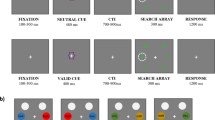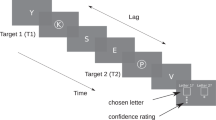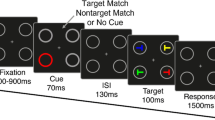Abstract
Picking-up and exploiting spatial and temporal regularities in the occurrence of sensory events is important for goal-directed behaviour. According to the “Predictive Coding Hypothesis” (Friston Philosophical Trans R Soc B 360(1456):815–836, 2005), these regularities are used to generate top-down predictions that are constantly compared with actual sensory events. In a previous study with the Attentional Blink (AB) paradigm, we showed that the temporal and probabilistic uncertainty of T2s that are presented outside the Attentional Blink period, i.e. at least 400 ms after T1, improves the conscious report of T2 that are presented inside the AB. The study of ERP correlated showed that this improvement was associated with a prolonged storage of pre-conscious T2 traces in extra-striate areas (Lasaponara et al. Cortex 71:15–33, 2015). Here, we tested whether variations in the probabilistic cueing of the position of a primary T1 visual target in a 4 × 4 letter array, modulate the retention of memory traces evoked by secondary letter targets (T2) that were presented in other positions of the array. Most important, in each trial, the identity of T2 was specified to participants upon disappearance of the array. We show that high probabilistic cueing facilitates T1 detection and improves the corresponding sensitivity index (d′). In contrast, retention and conscious report of secondary targets (T2) improves when the probabilistic cueing of T1 position is poor. These results suggest that uncertainty in the upcoming position of primary targets boosts the strength of memory traces evoked by secondary targets and improves the possibility that traces of secondary targets gain full access to conscious processing.






Similar content being viewed by others
References
Bashinski HS, Bacharach VR (1980) Enhancement of perceptual sensitivity as the result of selectively attending to spatial locations. Perception Psychophys 28(3):241–248. https://doi.org/10.3758/BF03204380
Cameron EL, Tai JC, Carrasco M (2002) Covert attention affects the psychometric function of contrast sensitivity. Vision Res 42(8):949–967. https://doi.org/10.1016/S0042-6989(02)00039-1
Camos V, Barrouillet P (2014) Attentional and non-attentional systems in the maintenance of verbal information in working memory: The executive and phonological loops. Front Hum Neurosci 8:900. https://doi.org/10.3389/fnhum.2014.00900
Carrasco M, Loula F, Ho Y-X (2006) How attention enhances spatial resolution: evidence from selective adaptation to spatial frequency. Perception Psychophys 68(6):1004–1012. https://doi.org/10.3758/BF03193361
Chun MM, Jiang Y (1998) Contextual cueing: implicit learning and memory of visual context guides spatial attention. Cogn Psychol 36(1):28–71. https://doi.org/10.1006/cogp.1998.0681
Cosman JD, Vecera SP (2014) Establishment of an attentional set via statistical learning. J Exp Psychol Hum Percept Perform 40(1):1–6. https://doi.org/10.1037/a0034489
Cowan N (2010) The magical mystery four: How is working memory capacity limited, and why? Current Directions in Psychological Science 19(1):51–57. https://doi.org/10.1177/0963721409359277
Downing CJ (1988) Expectancy and visual-spatial attention: effects on perceptual quality. J Exp Psychol Hum Percept Perform 14(2):188–202
Dragone A, Lasaponara S, Pinto M, Rotondaro F, De Luca M, Doricchi F (2018) Expectancy modulates pupil size during endogenous orienting of spatial attention. Cortex 102:57–66. https://doi.org/10.1016/j.cortex.2017.09.011
Friston K (2005) A theory of cortical responses. Philosophical Trans R Soc B 360(1456):815–836
Friston K (2010) The free-energy principle: a unified brain theory? Nat Rev Neurosci 11(2):127
Gattass R, Galkin TW, Desimone R, Ungerleider LG (2014) Subcortical connections of area V4 in the macaque. J Comparative Neurol 522(8):1941–1965
Geng JJ, Behrmann M (2002) Probability cuing of target location facilitates visual search implicitly in normal participants and patients with hemispatial neglect. Psychol Sci 13(6):520–525
Geng JJ, Behrmann M (2005) Spatial probability as an attentional cue in visual search. Perception Psychophys 67(7):1252–1268
Goujon A, Didierjean A, Thorpe S (2015) Investigating implicit statistical learning mechanisms through contextual cueing. Trends Cognitive Sci 19(9):524–533. https://doi.org/10.1016/j.tics.2015.07.009
Griffin IC, Nobre AC (2003) Orienting attention to locations in internal representations. J Cognitive Neurosci 15(8):1176–1194
Hawkins HL, Hillyard SA, Luck SJ, Mouloua M, Downing CJ, Woodward DP (1990) Visual attention modulates signal detectability. J Exp Psychol Hum Percept Perform 16(4):802–811. https://doi.org/10.1037/0096-1523.16.4.802
Jiang YV, Swallow KM, Rosenbaum GM (2013a) Guidance of spatial attention by incidental learning and endogenous cuing. J Exp Psychol Hum Percept Perform 39(1):285–297. https://doi.org/10.1037/a0028022
Jiang YV, Swallow KM, Rosenbaum GM, Herzig C (2013b) Rapid acquisition but slow extinction of an attentional bias in space. J Exp Psychol Hum Percept Perform 39(1):87–99. https://doi.org/10.1037/a0027611
Landman R, Spekreijse H, Lamme VA (2003) Large capacity storage of integrated objects before change blindness. Vision Res 43(2):149–164
Lasaponara S, Dragone A, Lecce F, Di Russo F, Doricchi F (2015) The “serendipitous brain”: Low expectancy and timing uncertainty of conscious events improve awareness of unconscious ones (evidence from the Attentional Blink). Cortex 71:15–33. https://doi.org/10.1016/j.cortex.2015.05.029
Lasaponara S, D’Onofrio M, Dragone A, Pinto M, Caratelli L, Doricchi F (2017) Changes in predictive cuing modulate the hemispheric distribution of the P1 inhibitory response to attentional targets. Neuropsychologia 99:156–164
Lasaponara S et al (2019) Expectancy modulates pupil size both during endogenous orienting and during re-orienting of spatial attention: a study with isoluminant stimuli. Eur J Neurosci. https://doi.org/10.1111/ejn.14391
Lepsien J, Griffin IC, Devlin JT, Nobre AC (2005) Directing spatial attention in mental representations: interactions between attentional orienting and working-memory load. Neuroimage 26(3):733–743
Lorch RF, Myers JL (1990) Regression analyses of repeated measures data in cognitive research. J Exp Psychol Learn Mem Cogn 16(1):149
Luck SJ, Chelazzi L, Hillyard SA, Desimone R (1997) Neural mechanisms of spatial selective attention in areas V1, V2, and V4 of macaque visual cortex. J Neurophysiol 77(1):24–42
Luck SJ, Hillyard SA (1994) Spatial filtering during visual search: evidence from human electrophysiology. J Exp Psychol Hum Percept Perform 20(5):1000
Luck SJ, Hillyard SA, Mouloua M, Woldorff MG, Clark VP, Hawkins HL (1994) Effects of spatial cuing on luminance detectability: psychophysical and electrophysiological evidence for early selection. J Exp Psychol Hum Percept Perform 20(4):887–904. https://doi.org/10.1037/0096-1523.20.4.887
Macaluso E, Doricchi F (2013) Attention and predictions: control of spatial attention beyond the endogenous-exogenous dichotomy. Front Hum Neurosci 7:685. https://doi.org/10.3389/fnhum.2013.00685
Marini F, Demeter E, Roberts KC, Chelazzi L, Woldorff MG (2016) Orchestrating proactive and reactive mechanisms for filtering distracting information: brain-behavior relationships revealed by a mixed-design fMRI study. J Neurosci 36(3):988–1000
Marini F, Chelazzi L, Maravita A (2013) The costly filtering of potential distraction: evidence for a supramodal mechanism. J Exp Psychol Gen 142(3):906
Meijs EL, Slagter HA, de Lange FP, van Gaal S (2018) Dynamic interactions between top-down expectations and conscious awareness. J Neurosci 38(9):2318–2327. https://doi.org/10.1523/JNEUROSCI.1952-17.2017
Mitchell JF, Sundberg KA, Reynolds JH (2009) Spatial attention decorrelates intrinsic activity fluctuations in macaque area V4. Neuron 63(6):879–888. https://doi.org/10.1016/j.neuron.2009.09.013
Oberauer K, Lewandowsky S (2014) Further evidence against decay in working memory. J Mem Lang 73:15–30. https://doi.org/10.1016/j.jml.2014.02.003
Pestilli F, Carrasco M (2005) Attention enhances contrast sensitivity at cued and impairs it at uncued locations. Vision Res 45(14):1867–1875. https://doi.org/10.1016/j.visres.2005.01.019
Posner MI (1980) Orienting of attention. Q J Exp Psychol 32(1):3–25. https://doi.org/10.1080/00335558008248231
Previc F (1990) Functional specialization in the lower and upper visual fields in humans: Its ecological origins and neurophysiological implications. Behav Brain Sci 13(3):519–542. https://doi.org/10.1017/S0140525X00080018
Previc FH (1996) Attentional and oculomotor influences on visual field anisotropies in visual search performance. Visual Cognition 3(3):277–302
Raymond JE, Shapiro KL, Arnell KM (1992) Temporary suppression of visual processing in an RSVP task: an attentional blink? J Exp Psychol Hum Percept Perform 18(3):849
Reinitz MT (1990) Effects of spatially directed attention on visual encoding. Perception Psychophys 47(5):497–505. https://doi.org/10.3758/BF03208183
Reynolds JH, Pasternak T, Desimone R (2000) Attention increases sensitivity of V4 neurons. Neuron 26(3):703–714
Schneider W, Eschman A, Zuccolotto A (2002) E-Prime: User’s guide. Psychology Software Incorporated.
Siegel M, Donner TH, Oostenveld R, Fries P, Engel AK (2008) Neuronal synchronization along the dorsal visual pathway reflects the focus of spatial attention. Neuron 60(4):709–719. https://doi.org/10.1016/j.neuron.2008.09.010
Silvetti M, Seurinck R, Verguts T (2013) Value and prediction error estimation account for volatility effects in ACC: a model-based fMRI study. Cortex 49(6):1627–1635
Sligte IG, Scholte HS, Lamme VAF (2009) V4 activity predicts the strength of visual short-term memory representations. J Neurosci 29(23):7432–7438. https://doi.org/10.1523/JNEUROSCI.0784-09.2009
Sligte IG, Scholte HS, Lamme VAF (2008) Are there multiple visual short-term memory stores? PLoS ONE 3(2):e1699. https://doi.org/10.1371/journal.pone.0001699
Sperling G (1960) The information available in brief visual presentations. Psychol Monographs 74(11):1
Todd JJ, Marois R (2004) Capacity limit of visual short-term memory in human posterior parietal cortex. Nature 428(6984):751–754. https://doi.org/10.1038/nature02466
Todd RM, Manaligod MG (2018) Implicit guidance of attention: the priority state space framework. Cortex 102:121–138
van Ede F, Chekroud SR, Nobre AC (2019) Human gaze tracks attentional focusing in memorized visual space. Nat Hum Behav 3(5):462–470. https://doi.org/10.1038/s41562-019-0549-y
Yeshurun Y, Carrasco M (1998) Attention improves or impairs visual performance by enhancing spatial resolution. Nature 396(6706):72–75. https://doi.org/10.1038/23936
Acknowledgements
This work was supported by grant “Ricerche di Ateneo” University La Sapienza 2018 to FD. S.L. was supported by a research grant from the Departement of Psychology (Medicine and Psychology Faculty) of University La Sapienza. Ma.P. was supported by a research grant from the Fondazione Santa Lucia IRCCS, Rome.
Open practices statement
The datasets analysed during the current study are available from the corresponding author on reasonable request.
Author information
Authors and Affiliations
Corresponding author
Additional information
Communicated by Francesca Frassinetti.
Publisher's Note
Springer Nature remains neutral with regard to jurisdictional claims in published maps and institutional affiliations.
Electronic supplementary material
Below is the link to the electronic supplementary material.
Rights and permissions
About this article
Cite this article
Lasaponara, S., Pinto, M., Pellegrino, M. et al. Spatial uncertainty improves the distribution of visual attention and the availability of sensory information for conscious report. Exp Brain Res 238, 2031–2040 (2020). https://doi.org/10.1007/s00221-020-05862-3
Received:
Accepted:
Published:
Issue Date:
DOI: https://doi.org/10.1007/s00221-020-05862-3




